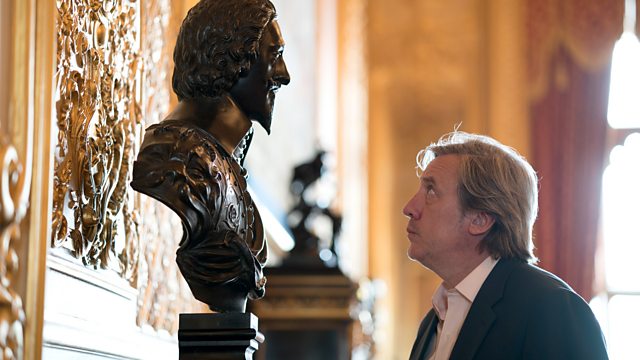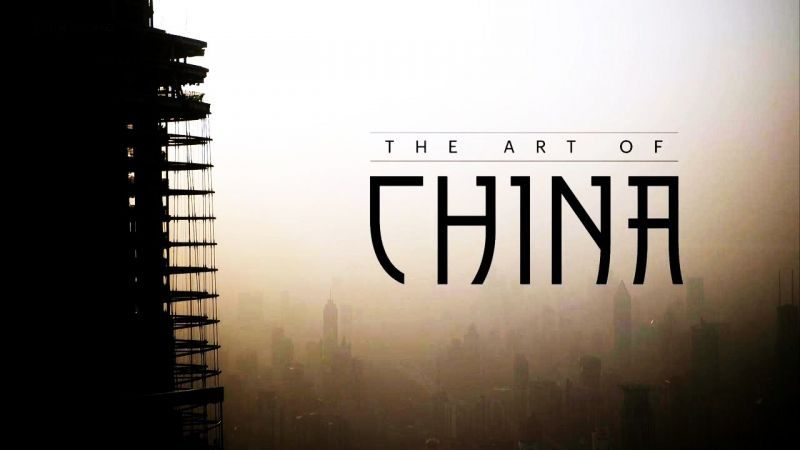Art, Passion & Power – The Story of the Royal Collection episode 1: In a major four-part series, Andrew Graham-Dixon explores the history of the Royal Collection, the dazzling collection of art and decorative objects owned by the Queen. Containing over a million items, this is one of the largest art collections in the world – its masterpieces by Van Dyck, Holbein, Leonardo da Vinci, Vermeer and Canaletto line the walls of Windsor Castle, Hampton Court and many other palaces, museums and institutions around Britain.
Andrew argues that on the surface, the Royal Collection projects permanence, but within these objects are stories of calamity, artistic passions and reinvention. Their collecting shows how these kings and queens wielded power, but it also reveals their personalities – it’s through their individual passions that we see them at their most human.
In this first episode of Art, Passion & Power, Andrew marvels at the works acquired by the great founders of the modern Royal Collection – Henry VIII and Charles I. Henry VIII deployed the most essential rule of royal collecting, that great art projects great power. Andrew decodes The Story of Abraham series of tapestries in Hampton Court Palace’s Great Hall, explaining how these luxury artworks contain a simple message for his terrified court – obedience.
Art, Passion & Power – The Story of the Royal Collection episode 1
But Henry also presided over the first great age of the portrait in England; his painter, Hans Holbein the Younger, was a magician who stopped time, preserving the faces of Henry’s court forever. Andrew visits the Royal Collection’s set of over 80 Holbein drawings in Windsor Castle’s print room to see how the artist helped the English to understand themselves in a new way.
Henry VIII tried to overwhelm with magnificence, but for Charles I art was a way to compete with other kings through taste. He was our first connoisseur-king and the greatest royal collector in British history. It was a fateful journey to Spain to win the hand of a Spanish princess that opened Charles’s eyes to the works of Titian and Raphael. But his transformation into a world-class collector was sealed with the wholesale purchase of the enormous art collection of the impoverished Mantuan court. The greatest of the Mantuan treasures were Mantegna’s nine-picture series of The Triumphs of Caesar that Charles installed at Hampton Court. They are themselves a visual depiction of how power – and art – passes from the weak to the strong. Charles was top dog for now – but for how long?
Andrew explores how Charles I’s Royal Collection introduced a new artistic language to British art. The sensuality of Titian and the epic canvases of Tintoretto, still in the Royal Collection today, were a revelation for a country whose visual culture had been obliterated by the Reformation. And we see how Sir Anthony van Dyck created a glamorous new style for the king that could have served as a new beginning for British art. But this was a future that would never happen – the English Civil War and Charles I’s execution put an end to this first great age of royal collecting, with the king’s artworks sold in ‘the most extravagant royal car-boot sale in history’.
Royal Collection
The Royal Collection of the British royal family is the largest private art collection in the world.
Spread among 13 occupied and historic royal residences in the United Kingdom, the collection is owned by Elizabeth II and overseen by the Royal Collection Trust. The Queen owns some of the collection in right of the Crown and some as a private individual. It is made up of over one million objects, including 7,000 paintings, over 150,000 works on paper, this including 30,000 watercolours and drawings, and about 450,000 photographs, as well as tapestries, furniture, ceramics, textiles, carriages, weapons, armour, jewellery, clocks, musical instruments, tableware, plants, manuscripts, books, and sculptures.
Some of the buildings which house the collection, like Hampton Court Palace, are open to the public and not lived in by the Royal Family, whilst others, like Windsor Castle and Kensington Palace, are both residences and open to the public. The Queen’s Gallery at Buckingham Palace in London was built specially to exhibit pieces from the collection on a rotating basis. There is a similar art gallery next to the Palace of Holyroodhouse in Edinburgh, and a Drawings Gallery at Windsor Castle. The Crown Jewels are on public display in the Jewel House at the Tower of London.
About 3,000 objects are on loan to museums throughout the world, and many others are lent on a temporary basis to exhibitions.





Pingback: Art, Passion & Power - The Story of the Royal Collection episode 2